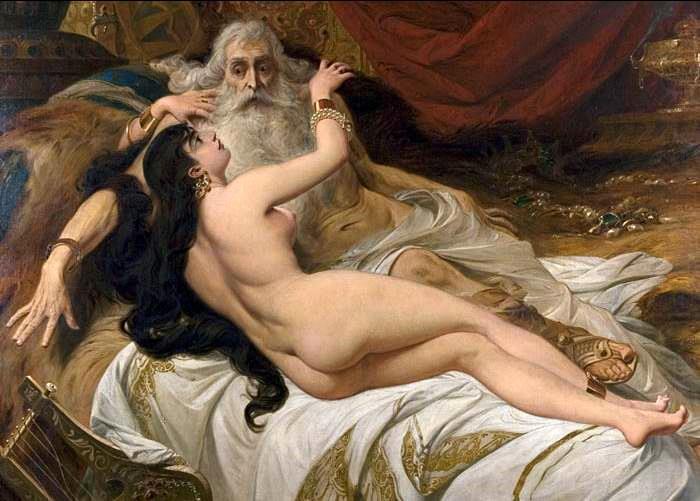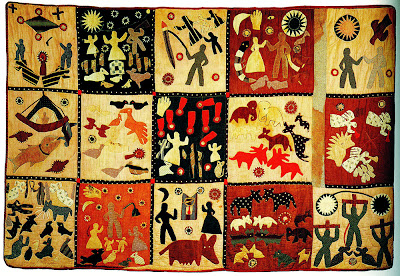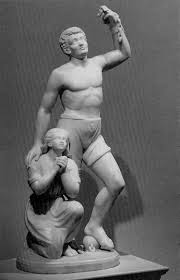Tiffany Saxton
Women and Art
3-8-2017
The Roles of Women throughout European History
The
woman’s role during the Middle Ages were inferior to their husband and or male
figure around the woman and her labor in a patriarchal society. The woman had to remain domestic due to
religious beliefs that the women had to obey her husbands and the church. Chadwick states, “…a number of power
upper-class women at a time when most other women were restricted to the home
and economically dependent on fathers, husbands, brothers, or sovereigns” (44). Women that were considered peasants were not close
to being equal with the men; however, the upper-class women had a slight chance
of having access to education Bible, something other than the religious
teachings. The Guerilla Girls mentions, “Many
of these artists were women, either working in businesses owned by male family members
or living as nuns in convents”. Many
women contributed to art; however, their names were not mentioned on major sculptures,
paintings etc. Chadwick mentions, “…for
few of them signed their names and the preservation of their individual biographies
had no role to play in their productions” (43).
Women were even ignored in scholar book as Guerilla Girls indicates, “One
scholarly book on the tapestry goes on and on about its historical and formal
sources, but completely ignores the women who executed it” (21). By highlighting the males, dismisses the
women intellectual capabilities and credits men for women work. Women were encouraged to fight for ownership
and rights in the feudal system and the differences were through embroidery
while remaining true to the church.
Chadwick writes, “While on the one hand, woman was suspect as sexual
threats to male chastity, on the other, spiritual commonality rather than
gender differentiation was the ideal of the Benedictine Rule and hence of monasticism”
(45). The church had control teaching
men giving them power, but not the same powers were issued to women leaving
women wanting more in society and art. 

Female objectification
https://edphoto2.wordpress.com/author/edphoto2/page/2/Men had power over women...seen here in the portrait of male gaze women objectifying themselves in order to please the male spectator.
The
roles for women changed throughout the Renaissance and into the 19th
century by being shunned and discredited in Europe, to becoming appreciated and
able to make a living in the economic world as well as being domesticated to
the household in America. Chadwick
explains, “Women quickly used their skills in needlework to connect the domestic
sphere and the public world of collective social action” (207). Women fought to be respected and became feminists
that fought for abolition of slavery, temperance, and universal suffrage in
America because doing so Europe was unheard of in the 19th century. Inventions of the camera as well as the usage
of the railroad system, women lived life on their terms like Rosa Bonheur even
cross dressing for success to get ahead in the artistic world. Guerilla Girls explains, “She made a life of
her own, one far more unconventional than those of her contemporaries, the
aesthetically-radical-but-socially-bourgeois Impressionists” (48). Rosa Bonheur encouraged woman to be brave
like other artists such as Mary Cassat, which they both were sculptors and amazing
painters; their art is in museums in New York and worked alongside the male
greats as well. Chadwick writes, “One of
Power’s two well-known quilts (both now in American museum collections) was
purchased after its exhibition at a Cotton Fair in 1886 by Jennie Smith …” (210). 

The needle printhttp://needleprint.blogspot.com/2014/04/free-jigsaw-download-harriet-powers.htmlHarrit powers quilts that made it into the museum.
Women were empowered and demand equal rights in
America and other women started to demand the same as well through social
interactions. Edmonia Lewis was an
African American artist that endured so much in America, due to racism she left
to go to Rome later to known for The Death of Cleopatra. Guerilla Girls states, “In Rome, she learned
to work in the then fashionable neoclassical style. She was taken under the wing of a group of
well to do American women artists, writers, and intellectuals many of them
lesbians. Among them were several marble
sculptors, including Harriet Hosmer and Anne Whitney, who were very
successful. They were the first all-female
art movement a girls’ club” (51). She proved black women had it in them to
become a successful artist by taking her artwork back to America to become
major in the artistic world of sculpturing.
 Death of Cleopatra ...Edmonia Lewis sculpture that made her worthy of a artist in America. Women were united and became huge names in the artistic world even
though historical artists such as most men tried to discredit and or leave them
out their work continues to speak for itself in major museums, Centennial Exhibitions,
and Smithsonian. Woman have been continuing
to make their way in the artistic world, intellectual world and domestically by
proving that you can overcome many obstacles in a patriarchal society. Making a change through art historically,
women accomplished more through feminism of solidarity by never giving up, also
by maintaining their faith, women continue to prove that their equal and at
times better realistically.
Death of Cleopatra ...Edmonia Lewis sculpture that made her worthy of a artist in America. Women were united and became huge names in the artistic world even
though historical artists such as most men tried to discredit and or leave them
out their work continues to speak for itself in major museums, Centennial Exhibitions,
and Smithsonian. Woman have been continuing
to make their way in the artistic world, intellectual world and domestically by
proving that you can overcome many obstacles in a patriarchal society. Making a change through art historically,
women accomplished more through feminism of solidarity by never giving up, also
by maintaining their faith, women continue to prove that their equal and at
times better realistically.
No comments:
Post a Comment